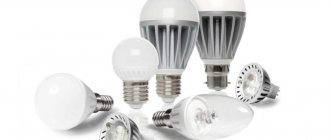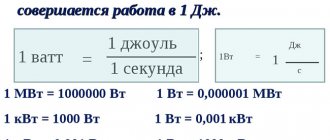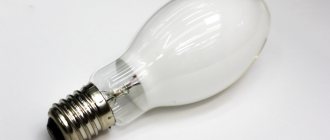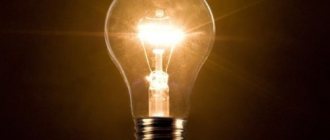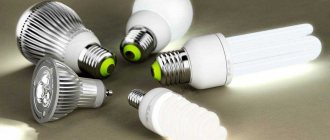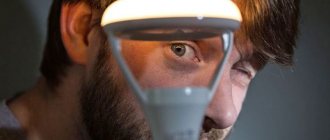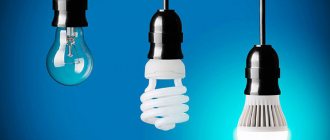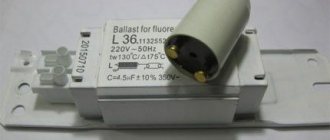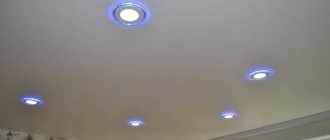Measure how well a light source emits visible light
Luminous output
it is a measure of how well a light source emits visible light.
It is the ratio of luminous flux to power, measured in lumens per watt in the International System of Units (SI). Depending on the context, power can be either the radiant power flow of the source, or it can be the total power (electrical, chemical, or other) consumed by the source.[1][2][3]What meaning of this term is intended should usually be inferred from context, and sometimes it's unclear. The first meaning is sometimes called the luminous efficiency of the radiation
, and the latter
the luminous efficiency of the source
or
the total luminous efficiency
.[4][5]
Not all wavelengths of light are equally visible or equally effective in stimulating human vision due to the spectral sensitivity of the human eye; Radiation in the infrared and ultraviolet parts of the spectrum are useless for lighting. The luminous efficiency of a source depends on how well it converts energy into electromagnetic radiation and how well the emitted radiation is detected by the human eye.
Luminous output of radiation
Explanation
The response of the typical human eye to light, as standardized by the CIE in 1924.
The horizontal axis represents the wavelength in nm. Wavelengths of light outside the visible spectrum are useless for lighting because they are not visible to the human eye. Moreover, the eye responds more to some wavelengths of light than others, even in the visible spectrum. This eye reaction is represented by a function of luminosity. This is a standardized function that represents the response of a “typical” eye in bright light (photopic vision). It is also possible to define a similar curve for unclear conditions (scopic vision). If nothing is specified, photopic conditions are usually assumed.
Luminous radiant efficiency measures the proportion of electromagnetic power that is used for illumination. It is obtained by dividing the luminous flux by radiant flux. Light with wavelengths outside the visible spectrum reduces luminous output because it promotes radiant flux, while the luminous flux of such light is zero. Wavelengths near the peak of the eye response contribute more than wavelengths near the edges.
The photopic luminous efficiency of radiation has a maximum possible value of 683.002 lm/W, for the case of monochromatic light at a wavelength of 555 nm (green). Scotopic luminous emission efficiency reaches a maximum of 1700 lm/W for monochromatic light at a wavelength of 507 nm.
Mathematical definition
Luminous output
, denoted
K
, is defined as[6]
K = Φ v Φ e = ∫ 0 ∞ K ( λ ) Φ e , λ d λ ∫ 0 ∞ Φ e , λ d λ , { displaystyle K = { frac { Phi _ { mathrm {v}}} { Phi _ { mathrm {e}}}} = { frac { int _ {0} ^ { infty} K ( lambda) Phi _ { mathrm {e}, lambda} , mathrm {d} lambda} { int _ {0} ^ { infty} Phi _ { mathrm {e}, lambda} , mathrm {d} lambda}},}
where
- Φv is the luminous flux;
- This is not a radiant flow;
- Φе, λ is the spectral radiant flux;
- K
(
λ
) =
K
m
V
(
λ
) is the spectral luminous efficiency.
Examples
Photopic vision
| Type | Luminous radiation efficiency (lm/W) | Luminous efficiency[note 1] |
| Tungsten incandescent lamp, standard, 2800 K | 15[7] | 2% |
| M class star (Antares, Betelgeuse), 3000 K | 30 | 4% |
| Blackbody, 4000K, ideal | 54.7[8] | 8% |
| Class G star (sun, Capella), 5800 K | 93[7] | 13.6% |
| Black body, 7000 K, ideal | 95[8] | 14% |
| Blackbody, 5800 K, trimmed to 400–700 nm (ideal "white" source)[note 2] | 251[7][note 3][9] | 37% |
| Blackbody, 5800 K, truncated to ≥ 5% photopic sensitivity range[note 4] | 348[9] | 51% |
| Ideal monochrome source: 555 nm | 683.002[10] | 100% |
Scotopic vision
| Type | Luminous radiation efficiency (lm/W) | Luminous efficiency[note 1] |
| Ideal monochromatic 507 nm source | 1699[11] or 1700[12] | 100% |
Spectral radiance from a black body. Energy outside the visible wavelength range (~380–750 nm, shown by gray dashed lines) reduces light output.
A simplified version of color difference thresholds. Credit: Xicato
There is also a new metric for LEDs; “color difference thresholds” (McAE). This became necessary due to the inconsistency in the color characteristics of LEDs after they come out of industrial assembly lines in the millions. The "color threshold" parameter is based on the principle of "barely noticeable difference" between LED chips. When a batch of chips has the same light output, they are classified as having the same color discrimination threshold. The greater the spread of indicators, the greater the number of color discrimination thresholds obtained.
A good manufacturer, as a rule, supplies products that have two or three color thresholds. If the stated number of thresholds exceeds six, look for another LED.
Again, as LEDs gain longevity and their color performance degrades, the number of color thresholds increases, indicating degradation of the original color rendering performance. Thus, another metric would be valuable: the deviation of the color thresholds over the nominal service life.
Lighting efficiency
Main article: Socket efficiency
Artificial light sources are usually rated in terms of the luminous efficiency of the source, also sometimes called socket efficiency
.
It is the relationship between the total luminous flux emitted by a device and the total amount of power (electrical, etc.) it consumes. The luminous output of a source is a measure of the efficiency of a device with an output power tuned to a spectral response curve (a function of luminance). Expressed in dimensionless form (for example, as a fraction of the maximum possible luminous output), this value may be called source luminous output
,
total luminous output
, or
lighting efficiency
.
The main difference between radiant luminous efficiency and source luminous efficiency is that the latter takes into account incoming energy that is lost as heat or otherwise exits the source as something other than electromagnetic radiation. Luminous radiation efficiency is a property of the radiation emitted by a source. The luminous output of a source is a property of the source as a whole.
Examples
The following table lists the source luminous output and efficiency for various light sources. Please note that all lamps requiring electrical/electronic ballast unless otherwise stated (see also voltage) are stated without penalty for this reduction in overall efficiency.
| Category | Type | Overall luminous efficiency (lm/W) | Overall luminous efficiency[note 1] |
| Combustion | Gas mantle | 1–2[13] | 0.15–0.3% |
| Incandescent lamp | 15, 40, 100 W tungsten incandescent lamp (230 V) | 8.0, 10.4, 13.8[14][15][16][17] | 1.2, 1.5, 2.0% |
| 5, 40, 100 W tungsten incandescent lamp (120 V) | 5, 12.6, 17.5[18] | 0.7, 1.8, 2.6% | |
| Halogen incandescent lamp | 100, 200, 500 W tungsten-halogen (230 V) | 16.7, 17.6, 19.8[19][17] | 2.4, 2.6, 2.9% |
| 2.6 W tungsten halogen (5.2 V) | 19.2[20] | 2.8% | |
| Halogen-IR (120 V) | 17.7–24.5[21] | 2.6–3.5% | |
| Tungsten Quartz Halogen (12-24V) | 24 | 3.5% | |
| Photographic and projection lamps | 35[22] | 5.1% | |
| Light-emitting diode | LED screw base lamp (120 V) | 102[23][24][25] | 14.9% |
| 5–16 LED lamp on screw base W (230 V) | 75–120[26] | 11–18% | |
| 21.5 Modernization of W LED for fluorescent lamp T8 (230 V) | 172[27] | 25% | |
| Theoretical limit for white LED with phosphorescence color mixing | 260–300[28] | 38.1–43.9% | |
| Arc lamp | Carbon arc lamp | 2–7[29] | 0.29–1.0% |
| Xenon arc lamp | 30–50[30][31] | 4.4–7.3% | |
| Mercury-xenon arc lamp | 50–55[30] | 7.3–8% | |
| Ultra high pressure (UHP) mercury vapor arc lamp, free installation | 58–78[32] | 8.5–11.4% | |
| Ultra-high pressure mercury vapor arc lamp (UHP) with reflector for projectors | 30–50[33] | 4.4–7.3% | |
| Fluorescent | 32 Tube W T12 with magnetic ballast | 60[34] | 9% |
| 9–32 W compact fluorescent (with ballast) | 46–75[17][35][36] | 8–11.45%[37] | |
| T8 tube with electronic ballast | 80–100[34] | 12–15% | |
| PL-S 11 W U-pipe, excluding ballast losses | 82[38] | 12% | |
| T5 tube | 70–104.2[39][40] | 10–15.63% | |
| 70–150 W electrodeless lighting system with inductive coupling | 71–84[41] | 10–12% | |
| Gas release | 1400 W sulfur lamp | 100[42] | 15% |
| Metal halide lamp | 65–115[43] | 9.5–17% | |
| High pressure sodium lamp | 85–150[17] | 12–22% | |
| Low pressure sodium lamp | 100–200[17][44][45] | 15–29% | |
| Plasma display panel | 2–10[46] | 0.3–1.5% | |
| Cathodoluminescence | Electron-stimulated luminescence | 30–110[47][48] | 15% |
| Ideal sources | Trimmed black body 5800 K[note 3] | 251[7] | 37% |
| Green light at 555 nm (maximum possible luminous output by definition) | 683.002[10] | 100% |
Sources that depend on the thermal radiation of a solid filament, such as incandescent lamps, tend to have low overall efficiency because, as Donald L. Klipstein explained, "an ideal thermal emitter emits visible light most efficiently at about 6300 °C (6600 K or 11500°F). Even at such a high temperature, a lot of radiation is infrared or ultraviolet, and the theoretical luminous [efficiency] is 95 lumens per watt. Neither substance is solid and can be used as a light bulb filament at temperatures close to this. the surface of the sun is not that hot."[22] At temperatures where the tungsten filament of a conventional light bulb remains solid (below 3683 kelvin), most of its radiation is in the infrared.[22]
Customizable white colors
Something that has recently become important is the color performance of “tunable white sources.” These are multi-channel LED light sources where the white light settings can be shifted between “warm” and “cool” temperatures. What is rarely pointed out is the effect on color rendering when going across the entire range. Ideally, changing color temperatures will follow the "ideal emitter" curve over the corresponding color temperature range. There will be lighting systems for which this information will be extremely important.
SI photometric units
SI photometric quantities
- v
- T
- e
| Quantity | Unit | Measurement | Notes | |||||
| Name | Symbol[nb 1] | Name | Symbol | Symbol | ||||
| Light energy | Q v[No. 3] | second lumen | ⋅s | T J | The clear second is sometimes called a talbot . | |||
| Luminous flux, luminous intensity | Φ [№ 3] | lumen (= candela steradians) | lm (= cd⋅sr) | J | Light energy per unit time | |||
| Light intensity | i v | candela (= lumens per steradian) | (=lm/sr) | J | Luminous flux per unit solid angle | |||
| Brightness | Lv _ | candela per square meter | cd/m2 (= lm/(sr⋅m2)) | L −2 J | Luminous flux per unit solid angle per unit projected source area. The candela per square meter is sometimes called the nit . | |||
| Illumination | Ev _ | lux (= lumens per square meter) | (=lm/m2) | L −2 J | Luminous flux incident on the surface | |||
| Luminous efficacy, luminous flux | Mv _ | lumen per square meter | lm/m2 | L −2 J | Luminous flux is emitted from the surface | |||
| Light exposure | HOUR v | luxury second | lx | L −2 T J | Time-integrated illuminance | |||
| Light energy density | ωv _ | lumen second per cubic meter | lm⋅s/m3 | L −3 T J | ||||
| Luminous output (radiation) | K | lumen per watt | lm / | M −1 L −2 T 3 J | Ratio of luminous flux to radiant flux | |||
| Luminous output (source) | η [№ 3] | lumen per watt | lm / | M −1 L −2 T 3 J | Ratio of luminous flux to power consumption | |||
| Luminous efficacy, luminous coefficient | V | 1 | Luminous output normalized to the maximum possible luminous output | |||||
| See also: · Photometry · Radiometry | ||||||||
- Standards organizations recommend denoting photometric quantities with the suffix "v" (for "visual") to avoid confusion with radiometric or photon quantities. For example: US Standard Letter Symbols for Lighting Engineering
USAS Z7.1-1967, Y10.18-1967 - The symbols in this column indicate dimensions; " L
", "
T
" and "
J
" represent length, time and luminous intensity respectively, rather than symbols for the units liter, tesla and joule. - ^ a b c
Alternative symbols are sometimes found:
W
for luminous energy,
n
or
F
for luminous flux, and
ρ
for luminous output of the source.
What does it depend on
In theory, it is believed that this data should only relate to the light source itself and in no way affect the entire luminaire.
However, practice shows that a huge contribution to the final result of luminous efficiency is made by:
- several spotlights
- speaker shape
- driver
- LED temperature mode
- uniform measurement conditions
Therefore, it would be more correct to call this term “light output of a lamp.” When purchasing, always ask about this parameter, for example, what is the power of a group of lighting fixtures, and not its LEDs inside.
Notes
- ^ a b c
Determined in such a way that the maximum possible luminous
efficiency
corresponds to a luminous
efficiency
of 100%. - The most effective source that simulates the solar spectrum within the limits of human visual sensitivity.
- ^ a b
Integral of the truncated Planck function times photopeak luminosity function times 683.002 lm/W. - Omits the part of the spectrum where eye sensitivity is low (≤ 5% of the peak).
Recommendations
- Allen Stimson (1974). Photometry and Radiometry for Engineers
. New York: Wiley and Son. - Frank Groom; Richard Becherer (1979). Optical Radiation Measurements, Volume 1
. New York: Academic Press. - Robert Boyd (1983). Radiometry and optical radiation detection
. New York: Wiley and Son. - Roger A. Messenger; Jerry Ventre (2004). Photovoltaic Systems Engineering
(2nd ed.). CRC Press. item 123. ISBN 978-0-8493-1793-4. - Eric Reinhard; Erum Arif Khan; Ahmet Oguz Akyuz; Garrett Johnson (2008). Color Imaging: Fundamentals and Applications
. A. K. Peters, LLC p.338. ISBN 978-1-56881-344-8. - "Luminous efficacy (radiation)." CIE. Retrieved 2016-06-07.
- ^ a b c d
“Maximum white light efficiency” (PDF). Retrieved 2011-07-31. - ^ a b
- ^ a b
Murphy, Thomas W. (2012).
"Maximum spectral luminous efficiency of white light." Journal of Applied Physics
.
111
(10):104909–104909–6. arXiv:1309.7039. Bibcode:2012JAP...111j4909M. doi:10.1063/1.4721897. S2CID 6543030. - ^ a b
"BIPM Statement: Information for Users on the Proposed Revision of the SI" (PDF). Archived (PDF) from the original January 21, 2022. Retrieved May 5, 2022. - Kohei Narisada; Duco Schreuder (2004). Handbook of Light Pollution
. Springer. ISBN 1-4020-2665-X. - Casimer DeCusatis (1998). Handbook of Applied Photometry
. Springer. ISBN 1-56396-416-3. - Westermeyer, F. W. (1920). "Recent Developments in Gas Street Lighting." American city
.
New York: Civic Press. 22
(5): 490. - "Philips Classictone Standard 15W, clear."
- "Philips Classictone Standard 40W, clear."
- "Lamps: Gluehbirne.ch: Philips standard lamps (in German)." Bulbs.ch. Retrieved 2013-05-17.
- ^ a b c d f
Philips Product Catalog (German) - Keefe, T.J. (2007). "The Nature of Light". Archived from the original on 01/2012/18. Retrieved 2016-04-15.
- Osram Halogen (PDF). osram.de
(in German). Archived from the original (PDF) on November 7, 2007. Retrieved 2008-01-28. - "Osram 6406330 Miniwatt-Halogen 5.2V." Bulbtronics.com. Archived from the original on 2016-02-13. Retrieved 2013-04-16.
- "GE Lighting HIR Plus Halogen PAR38s" (PDF). ge.com. Retrieved 2017-11-01.
- ^ a b c
Klipstein, Donald L. (1996). "The Great Online Light Bulb Book, Part I." Archived from the original on 2001-09-09. Retrieved 2006-04-16. - "Toshiba E-CORE LED lamp." item.rakuten.com. Retrieved 2013-05-17.
- "Toshiba E-CORE LDA5N-E17 LED lamp." Archived from the original on July 19, 2011.
- Toshiba to release 93 lm/W Ledrevie LED lamp
- "Philips - LED lamps." Received 2020-03-14.
- "MAS LEDtube 1500mm UE 21.5W 840 T8." Received 2018-01-10.
- White LEDs with ultra-high luminous efficiency Physorg.com
- "Arc lamps". Edison Technical Center. Retrieved 2015-08-20.
- ^ a b
"Technical information about lamps" (PDF).
Optical building blocks
. Retrieved 2010-05-01. Please note that the 150 lm/W value for xenon lamps is a typo. There is other useful information on the page. - Catalog of lamps and ballasts OSRAM Sylvania
. 2007. - REVIEW ARTICLE: UHP Lamps for Projection Applications[ permanent dead link
] Journal of Physics D: Applied Physics - OSRAM P-VIP PROJECTOR LAMPS Osram
- ^ a b
Federal Energy Management Program (December 2000). “How to buy an energy-efficient fluorescent lamp.” US Department of Energy. Archived from the original on 2007-07-02. Magazine citation required | log = (help) - “Low mercury CFL.” Energy Federation Incorporated. Archived from the original on October 13, 2008. Retrieved 2008-12-23.
- "Regular CFLs." Energy Federation Incorporated. Archived from the original on October 14, 2008. Retrieved 2008-12-23.
- "Global Bulbs". 1000Bulbs.com. Retrieved 2010-02-20.|
- Phillips. Phillips Master. Retrieved 2010-12-21.
- Department of Environment, Water, Heritage and the Arts, Australia. "Energy labeling - lamps." Archived from the original on July 23, 2008. Retrieved 2008-08-14.CS1 maint: multiple names: list of authors (link)
- BulbAmerica.com. Bulbamerica.com. Archived from the original on December 1, 2012. Retrieved 2010-02-20.
- SYLVANIA. "Sylvania Icetron Quicktronic Design Guide" (PDF). Retrieved 2015-06-10.
- “The 1000 W sulfur lamp is ready.” IAEEL Newsletter
(1). IAEEL. 1996. Archived from the original on August 18, 2003. - "The Advantage of Metal Halides". Venture Lighting
. 2007. Archived from the original on 2012-02-17. Retrieved 2008-08-10. - “LED or neon? Scientific comparison".
- “Why is the lightning colored? (Gas excitation).” webexhibits.org.
- "The future looks bright for plasma TVs" (PDF). Panasonic. 2007. Retrieved 2013-02-10.
- "TV-Tube Technology Creates an Efficient Light Bulb." OSA. 2019. Retrieved 2020-09-12.
- Sheshin, Evgeniy P.; Kolodyazhny, Artem Y.; Chadaev Nikolay N.; Getman Alexander Olegovich; Danilkin, Mikhail I.; Ozol, Dmitry Ivanovich (2019). "Prototype cathodoluminescent lamp for general lighting with field emission carbon fiber cathode." Journal of Vacuum Science and Technology
B.
AVS. 37
(3): 031213. doi:10.1116/1.5070108. Retrieved 2020-09-12.
